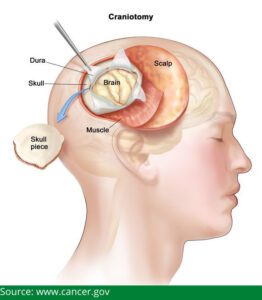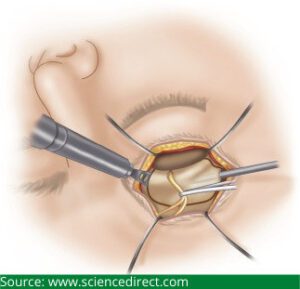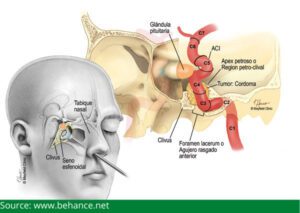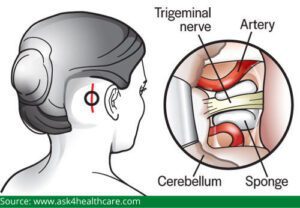One of the most common entities that neurosurgeons deal with is brain tumors, both benign and malignant. Surgery may be the only option for a benign or low-grade brain tumor, especially if the surgeon can remove the entire tumor.
Chemotherapy and radiation therapy may be used if the tumor is still visible after surgery. Surgery is frequently the first step in malignant or higher-grade cancers, followed by chemotherapy and radiation therapy.
Keyhole surgery is fast becoming the preferred approach due to its minimally invasive nature. Thus big open wounds or incisions are avoided. This results in less blood loss, tissue trauma, pain, and discomfort for the patient. Due to this, lesser analgesia is used, so patients experience fewer adverse effects.
Keyhole Surgery Procedure
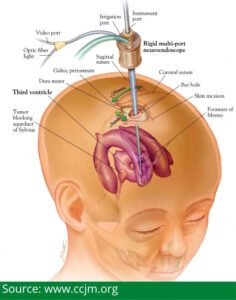 Keyhole surgery aims to safely remove tumors from the brain and skull base through smaller, more accurate holes that cause less collateral harm to the skull, brain, capillaries, and nerves. The surgeon then inserts small equipment via this incision to address the patient’s issue.
Keyhole surgery aims to safely remove tumors from the brain and skull base through smaller, more accurate holes that cause less collateral harm to the skull, brain, capillaries, and nerves. The surgeon then inserts small equipment via this incision to address the patient’s issue.
Real-time video imaging allows the surgeon to view the treatment region comprehensively. This enables them to observe in detail and operate on the problem area.
Dr. Gurneet Sawhney, one of the best neurosurgeons in Mumbai, India, has extensive experience in neurotrauma and minimally invasive approaches. He conducts surgeries using the latest instrumentation.
Neurological Conditions Treated Using Keyhole Brain Surgery
A benign or non-cancerous brain tumor is a group of cells that grows slowly in the same place without spreading. This tumor, if removed safely, is unlikely to return. Examples of benign tumors:
Meningioma – A tumor that develops just inside the skull on the membranes that shield the spinal cord and brain.
Pituitary Tumors – A tumor in the pituitary gland, a tiny brain gland situated behind the ear and back of the nose.
Craniopharyngioma – This tumor grows close to the pituitary gland and is usually made of solid masses and hollow fluid-filled sacs.
Vestibular Schwannoma (Acoustic Neuroma) – This tumor grows on nerves across the inner ear and brain. These nerves aid in balance and hearing, and tumor can restrict their function.
Malignant or cancerous brain tumors grow unrestrained locally and spread to other body areas. This cancerous tumor spreads to distant sites through the bloodstream or the lymphatic system (network of tissues and organs). Some examples of malignant tumors are:
Olfactory Neuroblastoma (Esthesioneuroblastoma) – This tumor usually occurs on the roof of the nasal cavity and disrupts our sense of smell. As it grows, it can spread into the eyes and brain.
Medulloblastoma – This tumor is most common in children 5-9 years of age and rare in people over 30. It starts at the cerebellum, a part of the brain at the bottom of the skull.
Glioblastoma – It is an intrusive and aggressive cancer growing from the brain and spinal cord tissues.
If you have any questions about tumors affecting the spine and brain, please do not hesitate to contact Dr. Gurneet Sawhney, a very renowned spine surgeon in Mumbai.
Common Keyhole Brain Surgeries
Craniotomy: A portion of the skull’s bone, known as the bone flap, is surgically removed to reveal the brain with specialized equipment. After the brain surgery, the bone flap is replaced.
Supraorbital Craniotomy: In this procedure, the surgeon makes a small incision within the eyebrow, followed by an opening of the skull. The affected area in the anterior skull base achieves total resection of the tumor without any scar that one would have in a standard craniotomy.
Endoscopic Endonasal Approach (EEA): It is a minimally invasive procedure in which a thin tube called an endoscope is threaded through your nose and sinuses. This allows your surgeon to reach sections of your brain that are difficult to get with conventional surgical techniques. Traditional surgical techniques often require larger incisions and removal of skull parts.
Retromastoid: An incision, a couple of centimeters in size, is made just behind the ear. The surgeon can then approach the targeted tumors and remove them. This is also used to perform microvascular decompression in cases of trigeminal neuralgia, an excruciating facial pain condition.
For more information, get in touch with Dr. Gurneet Sawhney, one of the best neurosurgeons in India. He has performed a multitude of brain tumor surgeries in Mumbai.
Benefits of Keyhole Brain Surgery Over Open Brain Surgery
- Patients have a much smaller incision
- Collateral damage to the surrounding tissue is lesser
- Patients have a faster recovery
- Infection rates are lower
- Patients need shorter hospitalization
- Tumor removal is safe and more precise
Conclusion:
The first goal of a neurosurgeon is to maintain and restore the patient’s quality of life. Efforts are being made at the global forefront to pioneer these minimally invasive approaches. The nature and location of the tumor dictate the best surgical strategy for each patient.
Keyhole surgery approaches are the best form of surgery to remove a tumor. The neurosurgeon strives to optimize tumor eradication by minimizing the manipulation of vital structures, regardless of the path taken.
As a result, problems and patient disfigurement are avoided, and a faster, more complete, and less painful recovery is promoted.
Dr. Gurneet Sawhney, one of the leading neurosurgeons in India, continually improves his anatomical understanding of the brain and skull base. He is passionate about alleviating patients’ problems more quickly and simply than the conventional methods.
If you or your loved one has any symptoms or has been diagnosed with a brain problem requiring surgery, feel free to contact the prominent neurosurgeon in Mumbai, Dr Gurneet Sawhney.

